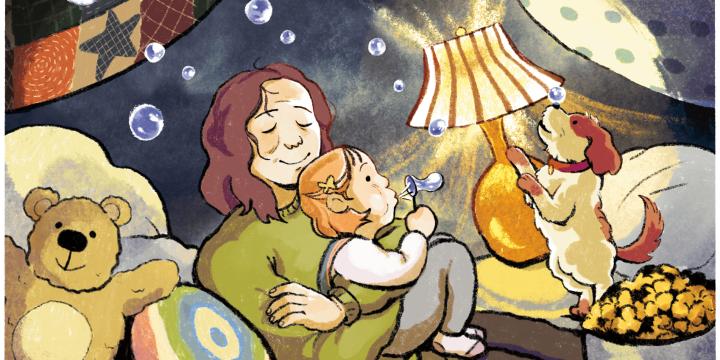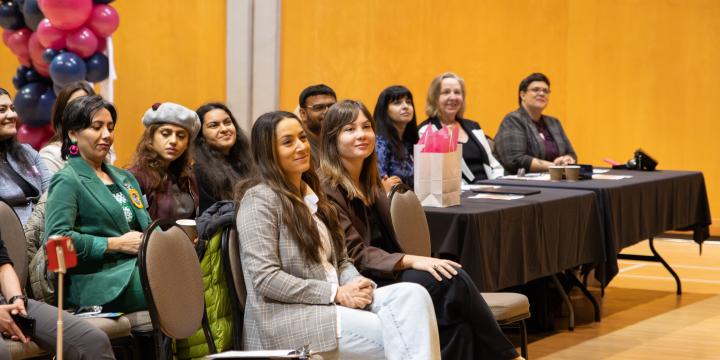
Voices of Diversity and Resilience: Celebrating Local Pan-Asian Voices in the Arts
In the face of challenges, barriers and discrimination, Pan-Asian communities have always rallied together to cultivate, innovate and breathe life into the spaces they gather. Despite enduring historical injustices, including those perpetuated by the Canadian government, these communities have often found solace and strength, particularly through artistic expression. Many individuals and groups have discovered their voice and cultural resilience through mastery of their craft, holding onto their roots amidst societal pressures that seek to marginalize Asian voices.
Asian Heritage Month serves as a reminder of this resilience and a time to acknowledge the Pan-Asian community’s important contributions.
Let’s celebrate those achieving incredible accomplishments through the arts, support organizations preserving cultural heritage and recognize the remarkable diversity within the Asian community.*
*For a clearer understanding of the Asian community's diverse geographical and cultural scope, please refer to the glossary definition provided at the bottom of this article.
Celebrating Pan-Asian Artists and Creators
In this piece, we’re choosing to spotlight a diverse group of Pan-Asian artists and creators whose works reflect the rich tapestry of their community's experiences. These individuals often had to navigate the art scene with little resources and connections, a reality common among immigrant communities striving to establish themselves in new environments. Their art flourished despite challenges, offering glimpses into their various lived experiences, grappling with complex issues, pushing against conventions and celebrating the rich tapestry of our collective humanity.
Anita Majumdar
Anita Majumdar, an award-winning, multifaceted artist of South Asian Canadian heritage, captures audiences with her performances that blend dance, theatre and storytelling. Through her solo shows and ensemble works, Majumdar explores themes of identity, tradition and gender dynamics, shedding light on the unique South Asian Canadian experiences. Majumdar continues to push artistic boundaries and inspire others to do the same.
Chrystal Phan
Chrystal Phan is a multidisciplinary artist. Her work spans various mediums, including painting, sculpture, installation, and performance art and often explores themes of cultural identity, memory, displacement and belonging. As a Vietnamese Canadian artist, Phan draws inspiration from her personal experiences as an immigrant, offering poignant reflections on the complexities of diasporic life. Beyond her individual art practice, Phan is actively involved in community-based art initiatives and collaborative projects, using her creativity as a tool for social commentary and advocacy.
Diyan Achjadi
Diyan Achjadi is a Vancouver-based, Indonesian Canadian printmaker and visual artist whose intricate and whimsical works explore themes of migration, hybridity and the environment. With a background in printmaking and drawing, Achjadi creates intricate patterns and surreal landscapes that blur the boundaries between the natural and the artificial. Through her playful art, Achjadi challenges viewers to reconsider their relationship to the world around them and to embrace the diversity and interconnectedness of life on these lands.
Jeff Chiba Stearns
Jeff Chiba Stearns is an Emmy-nominated and multi-award-winning animation and documentary filmmaker. Known for works such as "Yellow Sticky Notes" (2007), "One Big Hapa Family" (2010) and "Ode to a Post-it Note" (2010), Stearns captivates audiences with his diverse storytelling techniques. His films often delve into themes of multiculturalism, identity and belonging, drawing inspiration from his own mixed heritage. Through his art, Stearns illuminates the complexities of cultural identity, encouraging viewers to contemplate their own experiences and connections to the world around them.
Jin-me Yoon
Jin-me Yoon, an internationally acclaimed visual artist of Korean Canadian descent, challenges perceptions with her thought-provoking works. Yoon’s insights about social justice, colonialism and the environment were ahead of their time. Through photography, video installations and multimedia art, Yoon wrestles with notions of cultural identity, memory and representation. Her groundbreaking pieces serves as a platform for viewers to engage in critical dialogue, exploring the intersections of culture, history and personal narratives.
Lee Nam
Lee Nam, a Chinese immigrant to British Columbia in the early 20th century, had a significant yet overlooked impact on Canadian art history. Despite the prevailing exclusion of Chinese artists in historical narratives, Lee Nam's influence on renowned Canadian painter Emily Carr in the 1930s is notable. His painting studio served as a gathering place for ink brush practitioners from diverse backgrounds, fostering connections among Chinese, Hong Kongese, Taiwanese, and Canadian artists. Through his efforts, Lee Nam played a crucial role in bridging cultural divides and nurturing artistic collaboration in the Canadian art scene.
Mizuki Goto
Mizuki Goto is a Japanese Canadian ceramic artist known for her exquisite porcelain creations inspired by nature and traditional Japanese aesthetics. With meticulous attention to detail and a deep reverence for craftsmanship, Goto's ceramic pieces reflect the beauty and serenity of Japanese art and culture. Through her pottery workshops and exhibitions, Goto shares her passion for ceramics with the community, fostering appreciation for the art form and preserving Japanese craft traditions in British Columbia.
Parviz Tanavoli
Parviz Tanavoli, an Iranian-born artist based in West Vancouver, holds the esteemed title of the 'Father of modern Iranian sculpture.' Tanavoli has created over 100 pieces across various mediums, including sculpture, painting, printmaking, and mixed-media assemblages. His artistic journey draws inspiration from poetry, ancient Persian history, and storytelling, as he seeks to carve out his unique voice in the world of art, reflecting his deep exploration of cultural heritage and personal expression. Tanavoli's art serves as a bridge between past and present, inviting viewers to contemplate the rich tapestry of Iranian culture and the complexities of human existence.
Ravi Jain
Ravi Jain is a prominent Indian Canadian theatre director known for his innovative and thought-provoking productions. As the artistic director of Why Not Theatre, Jain explores themes of identity, belonging, and cultural heritage through his groundbreaking works. With his diverse background and creative vision, Jain challenges conventions and inspires audiences to reconsider their perspectives, fostering dialogue and understanding across cultural boundaries.
Sook Yin Lee
Sook Yin Lee, a versatile artist of Chinese Canadian heritage, captivates audiences with her compelling explorations of identity and belonging. She is a filmmaker, musician, actor, visual artist, radio & TV broadcaster and a former MuchMusic VJ. As a filmmaker, musician, and visual artist, Lee fearlessly dives into the complexities of the human experience, specifically working on films that discuss feminist and/or racial issues. Through her art, Lee invites viewers on a journey of introspection and connection, bridging cultures and illuminating the beauty of diversity.
Yumi Nagashima
Yumi Nagashima is a rising star in the Canadian comedy scene, known for her charm, sharp wit, stage presence and unique perspectives as a Japanese Canadian comedian. With her bold and hilarious stand-up routines, Nagashima tackles topics ranging from cultural differences to everyday happenings. As an advocate for diversity and inclusion, Nagashima's comedic talent and cultural insight shine a spotlight on the experiences and contributions of Asian Canadians in the entertainment industry.
Support Pan-Asian organizations preserving culture
Supporting organizations dedicated to preserving cultural heritage through art and creativity is essential for fostering community cohesion and celebrating the rich diversity of Asian voices. Let's take a closer look at some of these organizations and their invaluable contributions.
-
Chinatown Storytelling Centre: Dedicated to preserving and sharing the stories, memories and cultural heritage of Vancouver's Chinatown through exhibitions, oral history projects and community programs
https://www.chinatownstorytellingcentre.org/
-
Filipino Music and Art Association of Canada (FMAACI): Celebrates Filipino culture and heritage through music, dance, visual arts and literary works, providing a platform for Filipino Canadian artists to showcase their talents and share their stories
https://fmaaci.ca/
-
Indian Summer Arts Society: Promotes and showcases arts and culture from South Asia, particularly India, through festivals, performances, and educational initiatives, enriching the cultural landscape of Canada and inviting audiences to explore the richness and diversity of South Asian heritage.
https://indiansummerfest.ca/
-
Korean Cultural Heritage Society of BC (KCHSBC): Preserves and promotes Korean culture and heritage in British Columbia through educational programs, cultural events and community outreach, fostering connections between Korean Canadians and the broader community.
https://koreanculture.ca/
-
Nikkei National Museum & Cultural Centre: Serves as a vital hub for the preservation and celebration of Japanese Canadian heritage and culture through exhibitions, archives, educational programs and community events, ensuring that the stories and contributions of Japanese Canadians are remembered and honoured.
https://centre.nikkeiplace.org/
-
Rice & Beans Theatre: Founded by a diverse group of artists, Rice & Beans Theatre embraces multiculturalism and inclusivity. Through bold and innovative productions, the company redefines the boundaries of theatre, challenging perceptions of identity and belonging while weaving together stories that reflect the rich tapestry of Canadian society.
https://www.riceandbeanstheatre.com/
-
Southeast Asian Cultural Heritage Society: a non-profit organization dedicated to preserving, promoting, and celebrating the diverse cultural heritage of Southeast Asian communities. Based in Canada, SEACHS aims to raise awareness about the rich traditions, arts, languages, and histories of countries in the Southeast Asian region, including Thailand, Vietnam, Cambodia, Laos, Myanmar, Malaysia, Singapore, Indonesia and the Philippines.
https://www.seachs.org/
-
Vancouver Asian Canadian Theatre: Dedicated to Asian Canadian storytelling, challenges stereotypes and amplifies the voices of Asian Canadians on stage, providing opportunities for Asian Canadian playwrights, actors and directors to showcase their talents and share their stories.
https://vact.ca/
-
Vancouver Asian Heritage Month Society: Promotes awareness and appreciation of Asian Canadian arts and culture through the explorASIAN festival, showcasing the diversity and richness of Asian Canadian heritage through exhibitions, performances, workshops, and community events.
https://vahms.ca/
-
Vancouver Japanese Language School and Japanese Hall: Preserves Japanese language, culture, and traditions for generations through language classes, cultural programs, and community events, fostering a sense of belonging and connection among Japanese Canadians.
https://vjls-jh.com/
Glossary of Geographic and Pan-Asian Community Representation
Identities within Pan-Asian communities are multifaceted and overlapping, encompassing aspects such as ethnicity, gender, sexual orientation, languages spoken, religion, geographic location, socio-economic status, family history, political history and practices.
-
Central Asia
Afghani, Armenian, Azerbaijani, Georgians, Kazakh, Kyrgyz, Mongolian, Tajik, Turkmen, Uzbek.
-
East Asia
Chinese, Japanese, Korean, Okinawan, Taiwanese, Tibetan.
-
Southeast Asia
Bruneian, Burmese, Cambodian, Filipino (also regarded as Pacific Islanders), Hmong, Indonesian, Laotian, Malaysian, Mien, Singaporean, Timorese, Thai, Vietnamese.
-
South Asia
Bangladeshi, Bhutanese, Indian, Maldivians, Nepali, Pakistani, Sri Lankan
-
West Asia is typically referred to as the Middle East.
Geographically, it includes the countries of Bahrain, Iran, Iraq, Israel, Jordan, Kuwait, Lebanon, Oman, Palestine, Qatar, Saudi Arabia, Syria, Turkey (straddles Europe and Asia), United Arab Emirates, and Yemen.
Source: Asian Pacific Institute on Gender-Based Violence: api-gbv.org

